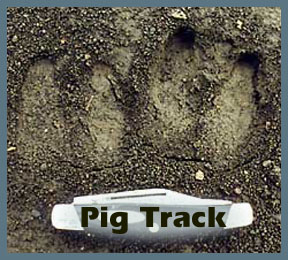
Last night, shots rang out and I knew the feral pig hunters were actively patrolling. The picture above is a skinny pig compared to the pictures my neighbor, Gary Gonzalez got of five pigs invading his yard July 4th. Sunday night, one of my Hanging Tree neighbors in a golf cart-like vehicle, with a powerful strobe light and a cross bow, was cruising the road flashing the woods looking for pigs. I’d planned to take a cool evening walk Monday night and thought better of it. Not only because of the hunters but because Gerry Baumgartner, another Hanging Tree neighbor reported he had been visited by a bear twice in the last two weeks and the neighbor above him has had three visits from two different bears. Both have armed themselves with canned horns. Its beginning to feel like an armed encampment here.

Bears and pigs are related and their meat tastes similar. I know that for a fact since I once butchered a bear for my brother who hunted and killed a bear in neighboring Tuolumne County when he was only 18 years old. Bears and feral pigs compete for the same food. Both can be aggressive and can and will attack humans if cornered or threatened, though that rarely happens. In the 1980′s I encountered feral pigs in Wilseyville and Railroad Flat, the upper, mountainous western part of Calaveras County. I’ve lived in Murphys since 1978 and have never seen a bear within two miles of my place, nor have I seen feral pigs. I find it somewhat disturbing to realize that the bear population and feral pigs are wandering into new territory. It makes me wonder what shift in the environmental balance caused them to hunger out of their range? From past experience, it is usually human activity that upsets the balance. In any case, one neighbor was feeling very sympathetic to the feral pigs being hunted and considered setting out corn for them. It seemed to be the right time to get educated about feral pigs and the damage they do. I looked at a couple of sources but Wisconsin Department of Natural Resources has the most thorough information on feral pigs and I copied my pictures from them:
http://www.dnr.state.wi.us/org/land/wildlife/PUBL/wlnotebook/Pig.htm
There are approximately four million feral pigs in the United States. Fact: more people are killed by pigs than sharks. Domestic pigs were originally brought here from Spain and allowed to propagate in the wilds of California. Russian razorbacks and pigs from Germany were brought to New Hampshire, the Carolinas and California in the early 1900′s. They are ferocious fighters, can produce two or more litters per year and live for 25 years. They’ve become a serious problem in 23 states.
Mountain lions, bobcats and bears will feed on young pigs but the adult pigs are voracious predators. President Roosevelt once watched a pig dismember a jaguar.
” They especially relish acorns as well as hickory and beech nuts in the autumn. At other times of the year they eat forbs, grasses, leaves, berries and other fruits, roots and tubers, corn and other agricultural crops, insects, crayfish, frogs, salamanders, snakes, mice, eggs of ground-nesting birds, young rabbits, fawns and young livestock, such as lambs, calves, kids. They can also kill larger livestock that are weak from illness or injury. When fresh meat is not available, feral pigs will also readily scavenge carrion.”
They destroy wetland habitat, muddying the waters, breaking down the banks of rivers, destroy aquatic plants and have been known to corner larger prey and hunt as a group, breaking legs and getting an animal on the ground. Their powerful bite can snap a kneecap or crush a peach pit with equal ease. They have been known to gnaw down a small tree and trample bushes in the wild. In domestic gardens and landscaped areas the damage is formidable. So, I say to my neighbor, don’t feel sorry for these invaders and let us support our hunters. In Wisconsin, they can be taken at anytime. In California, hunters need a pig tag, unless you are defending your property or livestock. I’m told they are better tasting than what we buy at the store. Luau time.
No comments:
Post a Comment